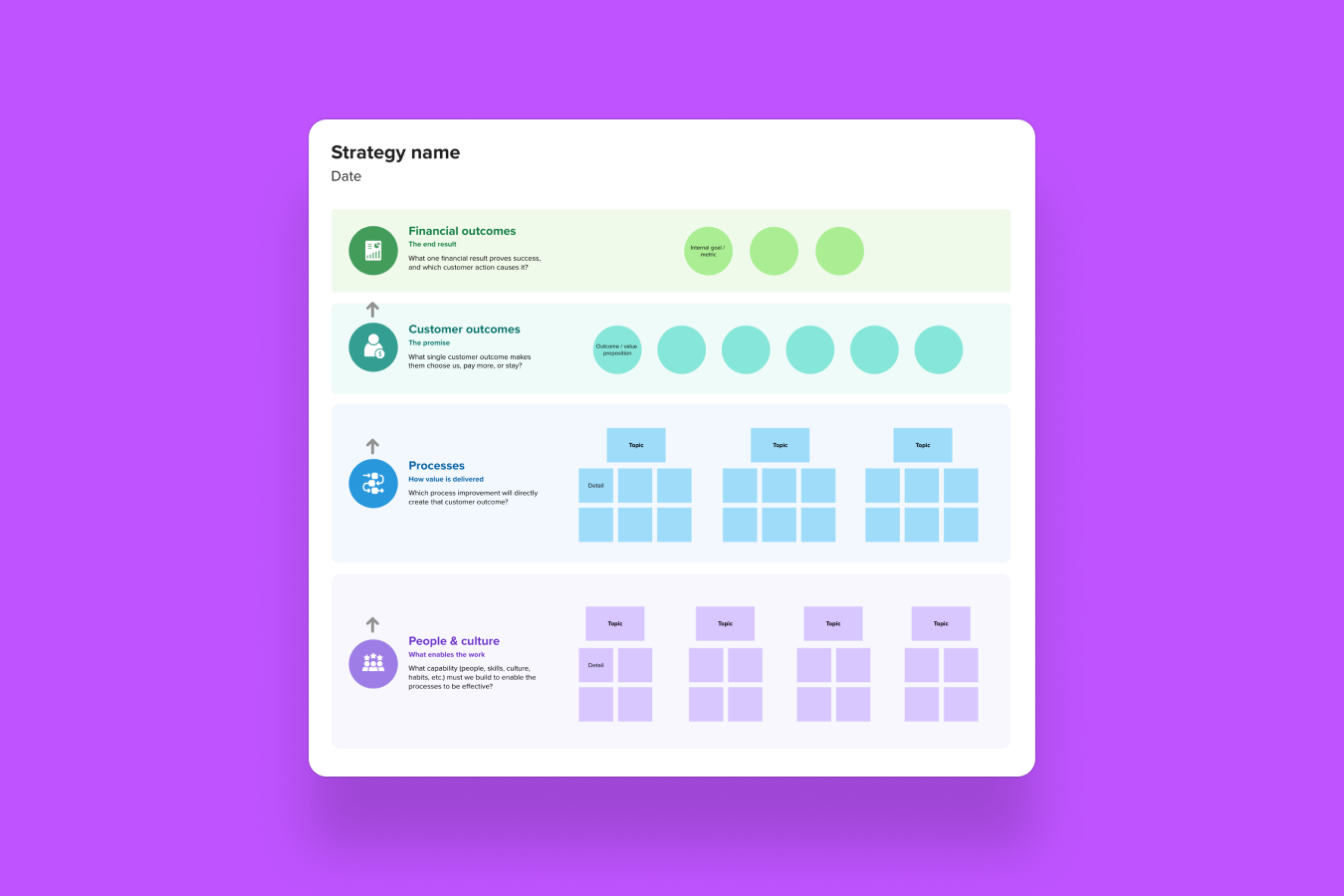On this page
Template use cases
Use Strategy map template
Get started
Strategize about how people and processes can positively impact your customers and organization

Use this framework to visualize goals for different areas of your business, and how they are interconnected through cause-effect.
The strategy map template makes it easy to see and understand the relationships between different departments and initiatives across your whole organization, helping you identify areas for improvement as well as pave the way for better cross-functional collaboration.
Visualize your goals across each area of your business
Understand the relationships between perspectives, goals, and objectives
Get broad alignment on your strategic objectives
Identify areas for improvement
To use Mural’s strategy map template, follow the steps outlined below with your team:
The first step is to define the various areas or perspectives across your business, using the left side of the template. Typically, the four perspectives in a strategy map are: Financial, Customer, Internal Process, and Learning & Growth (included in the template).
Using the color-coded sticky notes, add your objectives for each area of the business, keeping in mind that some areas may have many while others may have more limited (or broader) goals.
Finally, use connectors to show the relationships between different objectives across your whole organization. How do your internal processes affect the customer experience? How does that ladder up to your financial goals?
These relationships will be revealed as you add connectors within the template, opening up areas for improvement and discussion.
To get the most out of the Mural strategy map template with your team, you should:
Make sure to include a diverse group of stakeholders from across your organization, so that you can avoid any blind spots and correctly identify objectives for each area
Use Mural’s shapes and connectors to create a color-coded visual that describes the relationships across departments
Use your findings to identify any areas for improvement or overlap, and define cross-functional relationships
A strategy map template is a pre-designed framework or layout that provides a structured format for creating a strategy map. It serves as a starting point for organizations or individuals to develop their own strategy maps based on their unique strategic objectives, goals, and initiatives.
A strategy map is a visual representation of an organization's strategy, displaying the cause-and-effect relationships between various strategic objectives across different perspectives. These perspectives typically include Financial, Customer, Internal Process, and Learning & Growth.
The strategy map template outlines the structure of the strategy map and often includes placeholders for each perspective. It may also include guidance on what kind of objectives and key performance indicators (KPIs) to include under each perspective. This helps users understand the different elements that should be considered while building their strategy map.
Using a template streamlines the strategy mapping process and ensures that essential components are not overlooked. It provides a consistent and organized approach to creating strategy maps, making it easier for teams and stakeholders to understand and align with the organization's strategic goals.
While strategy map templates offer a standardized starting point, organizations should customize them to reflect their specific industry, business model, and strategic priorities. Each organization's strategy map will be unique, even if they use the same template, as it will be based on their distinct goals and objectives.
A strategy map is a visual representation of an organization's strategy, highlighting the cause-and-effect relationships between different strategic objectives. These objectives are grouped into four main perspectives, which help to provide a balanced view of the organization's strategy. The four perspectives are:
Financial perspective: This perspective focuses on the financial goals and objectives of the organization. It includes metrics related to profitability, revenue growth, cost management, and other financial indicators that are essential for the organization's success.
Customer perspective: This perspective centers on the customer's needs and requirements. It identifies the strategic objectives related to customer satisfaction, retention, market share, and other customer-focused metrics.
Internal process perspective: This perspective looks at the internal processes and operations of the organization. It identifies the critical processes that contribute to achieving the financial and customer objectives. Examples may include product development, supply chain management, or customer service processes.
Learning and growth perspective: This perspective emphasizes the organization's ability to learn, innovate, and grow. It includes objectives related to employee training, technology adoption, organizational culture, and other factors that enable continuous improvement.
A well-designed strategy map is crucial for effectively communicating and executing an organization's strategy. Here are some key elements that make a good strategy map:
Clarity and simplicity: The map should be clear and easy to understand at a glance. Avoid clutter and excessive detail, focusing on the most critical objectives.
Alignment: Ensure that the objectives across different perspectives align with each other and support the overall strategic goals of the organization. The cause-and-effect relationships should be logical and coherent.
Balanced perspective: The strategy map should offer a balanced view of the organization's strategy by covering all four perspectives (financial, customer, internal processes, and learning/growth). This ensures that the strategy addresses various aspects crucial for success.
Measurability: Each objective on the map should be tied to specific and measurable key performance indicators (KPIs). This helps in tracking progress and evaluating the effectiveness of the strategy.
Engaging visuals: Use appropriate visual elements like colors, icons, and charts to make the strategy map visually engaging and easy to remember.
Stakeholder involvement: Involve key stakeholders in the strategy mapping process to ensure their buy-in and to gather valuable insights from different perspectives.
Iterative design: Strategy maps are often refined over time as the organization evolves. Be prepared to update and improve the map based on new data, feedback, and changes in the business landscape.
Over 95% of the Fortune 100 use Mural to get things done.
No credit card required





